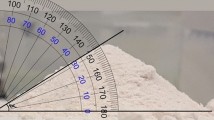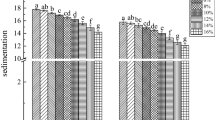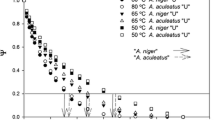Abstract
The effects of kneading and brushing on the physicochemical properties of “Dojo Hachiya” dried persimmon were investigated. All the “Dojo Hachiya” dried persimmons were produced using a traditional drying method, in which kneading and brushing techniques were used. During the drying process, secondary surface formation was observed. The moisture and sugar content, color, thickness, and texture of the secondary surface were measured. Sugar crystals on the surface were observed using scanning electron microscopy, and X-ray computed tomography was used to investigate the moisture distribution of the secondary surface. The results indicated that kneading treatment promoted moisture evaporation during drying and the final moisture contents of the four types (persimmons with kneading and brushing, persimmons with kneading and without brushing, persimmons without kneading and with brushing, persimmons without kneading or brushing) were 58.30%, 58.73%, 92.03%, and 90.85% (in dried basis), respectively; chroma indices (10.51, 11.22) of the samples with kneading were significantly (p < 0.05) lower than those (19.24, 20.84) of the samples that were not kneaded; kneading treatment also increased the thickness of the secondary surface from 2.75 to around 3.30 mm, and improved the texture properties (hardness, cohesiveness, springiness, gumminess, chewiness) of the secondary surface, whereas brushing had no obvious effects on these properties. The results of sugar analysis suggested that brushing enhanced sugar crystallization on the surface of the dried persimmon. This information provides fundamental knowledge that can facilitate production of high-quality dried persimmon and may help in improving the quality of dried persimmon through improved drying and storage methods.













Similar content being viewed by others
References
Ansari, S., Maftoon-Azad, N., Farahnaky, A., Hosseini, E., & Badii, F. (2014). Effect of moisture content on textural attributes of dried figs. International Agrophysics, 28(4), 103–412.
Ayuko, E., Ikeda, H., & Baba, N. (2017). Processing method by two-stage drying for soft-type dried persimmon using pollination constant non-astringent persimmon fruits cv. ‘Fuyu’ Diospyros kaki Thumb. Bulletin of the Fukuoka Agriculture and Forestry Research Center, (3), 43-48. (In Japanese).
Calín-Sánchez, A., Kharaghani, A., Lech, K., Figiel, A., Carbonell-Barrachina, A. A., & Tsotsas, E. (2015). Drying kinetics and microstructural and sensory properties of black chokeberry (Aronia melanocarpa) as affected by drying method. Food and Bioprocess Technology, 8, 63–74.
Celik, A., & Ercisli, S. (2007). Persimmon cv. Hachiya (Diospyros kaki Thunb.) fruit: some physical, chemical and nutritional properties. International Journal of Food Science and Nutrition, 59(7–8), 599–606.
Cho, J. H., Song, I. K., Cho, D. H., Dhungana, S. K., Ahn, H., & Kim, I. I.-D. (2017). Quality characteristics of dried persimmon (Diospyros kaki Thunb) of different fruit sizes. African Journal of Biotechnology, 16(9), 429–433.
Chen, J. Y., Du, J., Ge, Z. Z., Zhu, W., Nie, R. Z., & Li, C. M. (2016). Comparison of sensory and compositions of five selected persimmon cultivars (Diospyros kaki L.) and correlations between chemical components and processing characteristics. Journal of Food Science and Technology, 53(3), 1597–1607.
Chong, C. H., Law, C. L., Cloke, M., Abdullah, L. C., & Daud, W. R. W. (2008). Drying kinetics, texture, color, and determination of effective diffusivities during sun drying of Chempedak. Drying Technology, 26, 1286–1293.
Demiray, E., & Tulek, Y. (2017). The effect of pretreatments on air drying characteristics of persimmons. Heat and Mass Transfer, 53(1), 99–106.
Fernandes, F. A. N., Rodrigues, S., Law, C. L., & Mujumdar, A. S. (2011). Drying of exotic tropical fruits: a comprehensive review. Food and Bioprocess Technology, 4(2), 163–185.
Fernandes, F. A. N., Rodrigues, S., Cárcel, J. A., & García-Pérez, J. V. (2015). Ultrasound-assisted air-drying of apple (Malus domestica L.) and its effects on the vitamin of the dried product. Food and Bioprocess Technology, 8(7), 1503–1511.
García-Martínez, E., Igual, M., Martín-Esparza, M. E., & Martínez-Navarrete, N. (2013). Assessment of the bioactive compounds, color, and mechanical properties of apricots as affected by drying treatment. Food and Bioprocess Technology, 6(11), 3247–3255.
Garcia-Perez, J. V., Ortuño, C., Puig, A., Carcel, J. A., & Perez-Munuera, I. (2012). Enhancement of water transport and microstructural changes induced by high-intensity ultrasound application on orange peel drying. Food and Bioprocess Technology, 5(6), 2256–2265.
Garcia, C. C., Caetano, L. C., Souza Silva, K., & Mauro, M. A. (2014). Influence of edible coating on the drying and quality of papaya (Carica papaya). Food and Bioprocess Technology, 7(10), 2828–2839.
Guiné, R. P. F., & Barroca, M. J. (2012). Effect of drying treatments on texture and color of vegetables (pumpkin and green pepper). Food and Bioproducts Processing, 90, 58–63.
Hayashi, S. (1989). Secondary surface and its detection on a drying process of persimmon. Journal of the Japanese Society of Agricultural Mechanism, 51(5), 71–77 (In Japanese).
Hayashi, S. (1990). Tests of quality on preserving dried persimmons. The Japanese Society of Agricultural Machinery and Food Engineers, 52(1), 95–99 (In Japanese).
Hirai, S., & Yamazaki, K. (1984). Studies on sugar components of sweet and astringent persimmon by gas chromatography. Nippon Shokuhin Kogyo Gakkaishi, 31(1), 24–30 (In Japanese).
Ishii, Y., & Yamanishi, T. (1982). The changes of tannin and free sugars of astringent persimmon in the process of sun drying. Nippon Shokuhin Kogyo Gakkaishi, 29(12), 720–723 (In Japanese).
Karakasova, L., Babanovska-Milenkovska, F., Lazov, M., Karakasov, B., & Stojanova, M. (2013). Quality properties of solar dried persimmon (Diospyros kaki). Journal of Hygienic Engineering and Design, 4, 54–59.
Kawaguchi, H., Takeda, M., Tanaka, A., Inayoshi, K., Sugiwaka, Y., Koguchi, T., Takahara, Y., Murakami, S., Munesawa, H., & Mizutani, F. (2012). Effects of hand softening on ethanol production and astringency removal in peeled persimmon fruit. Bulletin of the Experimental Farm, Faculty of Agriculture, Ehime University, 34, 11–16 (In Japanese).
Maskan, M. (2001). Kinetics of colour change of kiwifruits during hot air and microwave drying. Journal of Food Engineering, 48(2), 169–175.
Nicoleti, J. F., Silveira-Jr, V., Telis-Romero, J., & Telis, V. R. N. (2005). Viscoelastic behavior of persimmon dried at constant air temperature. Journal of Lebensm.-Wiss.u.-Technol., 38, 143-150.
Ong, S. P., Law, C. L., & Hii, C. L. (2012). Effect of pre-treatment and drying method on colour degradation kinetics of dried salak fruit during storage. Food and Bioprocess Technology, 5(6), 2331–2341.
Park, Y. S., Jung, S. T., Kang, S. G., Efren, D. L., Ayala, A. L. M., Tapia, M. S., Olga, M. B., Trakhtenberg, S., & Gorinstein, S. (2006). Drying of persimmon (Diospyros kaki L.) and the following changes in the studied bioactive compounds and the total radical scavenging activities. Lebensmittel-Wissenschaft und -Technologie, 39, 748–755.
Peng, J., Bi, J. F., Yi, J. Y., Wu, X. Y., Zhou, M., Lyu, J., & Liu, J. N. (2018). Engineering texture properties of instant controlled pressure drop (DIC) dried carrot chips via modulating osmotic conditions. Food and Bioprocess Technology, 11, 1674–1685.
Romano, G., Baranyai, L., Gottschalk, K., & Zude, M. (2008). An approach for monitoring the moisture content changes of drying banana slices with laser light back scattering imaging. Food and Bioprocess Technology, 1(4), 410–414.
Seerangurayar, T., Al-Ismaili, A. M., Janitha Jeewanthaa, L. H., & Al-Habsib, N. A. (2019). Effect of solar drying methods on color kinetics and texture of dates. Food and Bioproducts Processing. https://doi.org/10.1016/j.fbp.2019.03.012.
Silva, K. S., Garcia, C. C., Amado, L. R., & Mauro, M. A. (2015). Effects of edible coatings on convective drying and characteristics of the dried pineapple. Food and Bioprocess Technology, 8(7), 1465–1475.
Sugiura, A., & Taira, S. (2008). Dried persimmon production in Japan. ISHS Acta Horticulturae 833: IV international symposium on persimmon, 71-76.
Suntudprom, J. (2014). Controlling processing for persimmon product texture. Manawatū: Massey University.
Szczesniak, A. S. (2002). Texture is a sensory property. Food Quality and Preference, 13, 215–225.
Tulek, Y., & Demiray, E. (2014). Effect of hot air drying and different pretreatments on color and drying characteristics of persimmons. Journal of Agricultural Sciences, 20, 27–37.
Wei, X., Liu, F., Qiu, Z. J., Shao, Y. N., & He, Y. (2014). Ripeness classification of astringent persimmon using hyperspectral imaging technique. Food and Bioprocess Technology, 7(5), 1371–1380.
Yamada, H., Ando, T., Tsutani, K., Amano, S., & Yamamoto, Y. (2009). Mechanism of browning occurring during the processing of semi-dried persimmon. Journal of the Japanese Society for Horticultural Science, 78(1), 124–130.
Yonemori, K., & Matsushima, J. (1987). Changes in tannin cell morphology with growth and development of Japanese persimmon fruit. Journal of American Society for Horticultural Science, 112, 818–821.
Zielinska, M., Zielinska, D., & Markowski, M. (2018). The effect of microwave-vacuum pretreatment on the drying kinetics, color and the content of bioactive compounds in osmo-microwave-vacuum dried cranberries (Vaccinium macrocarpon). Food and Bioprocess Technology, 11(3), 585–602.
Acknowledgements
The authors would like to acknowledge the China Scholarship Council for providing a scholarship to support the author (Xiwu Jia) to study in Japan. We also thank the government of Minokamo City for providing the opportunity to conduct this study and thank to the Japan Agricultural Cooperatives, MEGUMINO for providing the dried persimmons.
Author information
Authors and Affiliations
Corresponding author
Additional information
Publisher’s Note
Springer Nature remains neutral with regard to jurisdictional claims in published maps and institutional affiliations.
Rights and permissions
About this article
Cite this article
Jia, X., Katsuno, N. & Nishizu, T. Effect of Kneading and Brushing on the Physicochemical Properties of “Dojo Hachiya” Dried Persimmon. Food Bioprocess Technol 13, 871–881 (2020). https://doi.org/10.1007/s11947-020-02444-7
Received:
Accepted:
Published:
Issue Date:
DOI: https://doi.org/10.1007/s11947-020-02444-7




